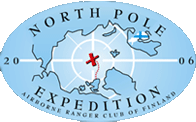Today's diary entry is a special tribute to blind people everywhere. We know what you endure.
The weather was overcast and messy. Visibility was low. Added to this, total whiteout conditions continued to tease us. During the morning we had to use the tips of our skis and our ski-poles as `tentacles´ to `feel´ our way forward. It wasn't easy. In fact, towards the end of the morning, it ceased to be enjoyable in any sense of the word. The terrain was rough also, and with visibility so poor, it was difficult to pick a sensible route through the icescape.
Around lunch time, fortunately, the weather cleared somewhat, and we could see again. However, the improved visibility only allowed us to better see the next challenge facing us: another ice-covered lead. The ice was too thin to ski on. Perttu [Ojala] swam across the lead, drawing a rope behind him. Then began another ferry-shuttle operation to get the gear and men, safe and dry, to the north shore of the lead. It was a very hard day's work, and we are satisfied with the progress made.
In the course of the average Expedition day there is, of course, plenty of time to ponder Life's Big Questions while you're trudging your way the Pole. One topic that the whole team seems to be pondering is ICE. Ice is constantly in our thoughts and conversations. After all, if your entire world is made of the stuff, it's a hard subject to avoid. The following are just a few examples of unresolved ICE questions:
- How many shapes and forms can ice made from sea water actually assume?
- How on Earth can these wild and wonderful shapes and forms be sculptured merely by Nature's hand; driven only by the fickle movements of wind, sea currents and ice flows?
- Why can't Nature make flat ice in the Arctic? Is that too much for a humble bunch of Finnish explorers to ask for?
- If you put a tray of ice-cubes in the freezer, don't they come out relatively level? As far as we are concerned, it would be quite enough for Mother Nature to spread out before us the wrinkled old skin of 117-year-old hag. But we can't even get any of that, either …
- Why does ice always have to be blue? In the long run, blue ice gets boring. It would be more uplifting if the color of the ice changed as we progressed towards the Pole. The ice between the 88th and 89th parallels could all be, say, green. When you cross the 89th parallel, the ice would turn red. Bull'seye! At least you would know you'd reached the North Pole!
Do not worry, dear followers:
All is well with our Expedition.
